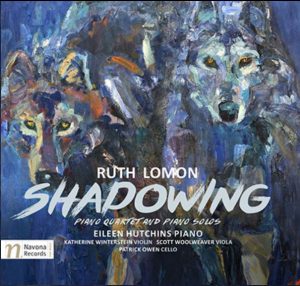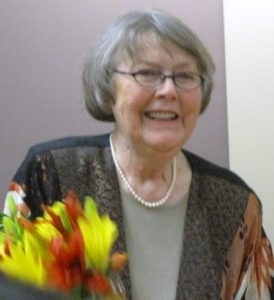While we rarely publish CD reviews on our blog, we decided it was important to give coverage to a recent CD by composer Ruth Lomon. Ruth’s music ranges from expressive and lyrical to electrifyingly engaging. But not only that, Ruth has always been seriously dedicated to promoting the work of other women composers, through projects such as pioneering work (in the 1970s and 80s) with American Women Composers, Inc. (which in 1995 became part of the IAWM) of researching repertoire and organizing concerts and conferences, to her more recent work of orchestrating the Viola Sonata by Rebecca Clarke (info here, recording here). — Liane Curtis
RUTH LOMON: SHADOWING (2017, Navona Records)
by Chris A. Trotman
This recent 2017 CD, Shadowing, features four works by acclaimed composer Ruth Lomon (b. 1930, Montréal). They include her Shadowing piano quartet and three solo piano works, one of which is a set of variations; the other two consist of multiple movements.
An accomplished pianist herself, Ruth Lomon employs many diverse styles and challenging piano techniques, such as repeated notes and dampened strings, in the theme and ten variations of her solo piano work, The Sunflower Variations (my favorite work on the album). The lyrical theme (which is based on her song The Sunflower), the eclectic rhythmic patterns and the colorful harmonic sonorities are progressively varied within each consecutive variation, and each section naturally continues to the next with the theme returning at the close. Also, the work is dedicated to the album’s pianist, Eileen Hutchins, and it is quite satisfying and appropriate to hear the intricate and passionate masterpiece expertly performed by its dedicatee! The same care and skill in terms of clarity, phrasing and rhythmical nuance by Hutchins is clearly evident in the other piano performances, both solo and chamber.
The three movements of Lomon’s Shadowing piano quartet are essentially programmatic, that is, intended to evoke images or convey the impression of events. According to the liner notes, she was influenced by the “magical passages of movement and color” found in the book Women Who Run with the Wolves by Clarissa Pinkola Estés. “Shadowing” is explained as “having such a light touch as to move freely without being observed or manifesting only to become like smoke and then manifesting again.” The second movement, with its seemingly random pizzicato notes, gives the impression of suspended time and space. These impressions are vividly brought to life by Eileen Hutchins (piano), Katherine Winterstein (violin), Scott Woolweaver (viola) and Patrick Owen (cello).
Like the variations, Esquisses (Sketches) contains diverse motivic and rhythmic elements as well as exquisite tonal sonorities. Also, like Shadowing and other works by Lomon, parts of the work contains programmatic elements, such as the tolling of bells in the opening movement Les Cloches (The Bells).
In Five Ceremonial Masks, Lomon stimulates the mind with images and events based on five Navaho masks used in the Yeibichai Night Chant ceremonies. The album booklet includes a color photograph of the five buckskin masks. Like The Sunflower Variations, Lomon uses advanced techniques within this work, such as having the performer dampen the strings and even performing glissandi directly on the strings with a timpani stick or leather mallet. As a bonus, there is a second recording of this work by the composer!
These works are among Ruth Lomon’s finest solo and chamber works, and they wonderfully demonstrate her extensive palette of harmonic colors and her expressive rhythmic flexibility as well as reveal her sense of musical narrative and sound painting in depicting diverse images and events through program music. Brava!
Audio clip here Publisher’s page
– Chris A. Trotman, M.M./M.L.I.S.
Women’s Philharmonic Advocacy
Director of Music Publications and
Editor-in-Chief of Amy Beach Project
